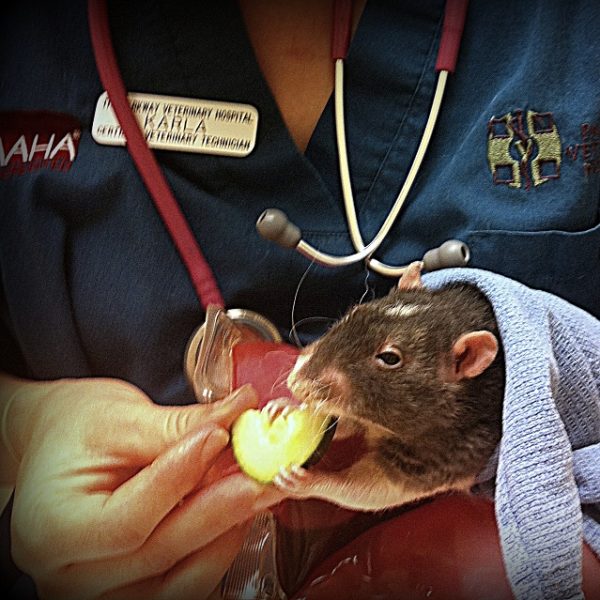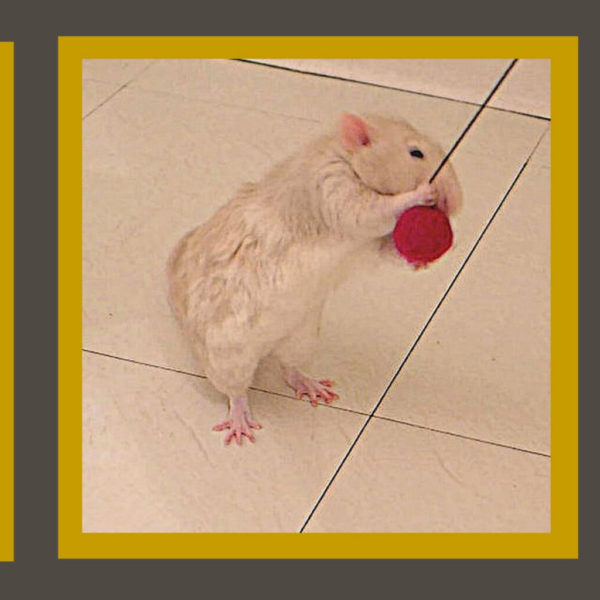
It may be the last thing you feel like doing. But it’s most often ESSENTIAL your remaining, newly single rat acquires a new friend.
Here are a few of the many reasons you’ll want to get a new buddy for your now single rat:
Rats Enjoy….
- Playing together
- Cuddling and sleeping snuggled up close to each other
- Grooming one another
Introducing a new rat is good for YOU, too:
Opening your heart and home to a new rat is very satisfying and rewarding for you as well as for your remaining rat. If you always have at least two rats, you’ll be thankful there’s still one left to care for when one dies. You’ll console one another.
The two exceptions—when it’s not a good idea to introduce a new rat—are when your remaining rat is either very old and/or very sick. In these cases, the introductory process is too stressful to be of benefit.
“But my single rat seems so happy alone…..”
If your remaining rat is lonely, you may notice changes in appetite or activity level. Sleeping more and/or playing less can also be indications of lonesomeness. On the other hand, your lone rat could seem perfectly happy. Even so, once you introduce a new friend, you’re likely to see your remaining rat become even happier.
I recently introduced my 2-year-old spayed female to a new friend. Her new friend was an 8-week-old unneutered male. I’d thought my female rat, Twyla, was doing fine on her own after her companion had died. However, knowing it’s best for her to have at least one rat friend, I went ahead and adopted Henderson. Once they began living together, Twyla literally acted as if she was reborn. She now plays much more and even has a new bounce in her step.
How soon should you adopt a new friend for your single rat?
In my opinion, the sooner you adopt a friend for your single rat the better. Your new rat will need to be quarantined for three weeks and then the introductory process can take as long as two weeks. It’ll be a month or more before your remaining rat will be living with his or her new friend. Even though it may seem lengthy, the quarantine period is a wonderful opportunity for one-on-one time, helping to deepen your bond with each of your rats.

Should I get a male or female? A young rat or an adult?
When adopting a friend of the opposite sex, you’ll want to make sure at least one is spayed or neutered. If needed, you can always have a rat neutered or spayed during the quarantine period. This gives them the added benefit of recovering from surgery while they’re in their own separate housing.
If your newly single rat is a male, it is often much easier to introduce a female. This certainly isn’t always the case. However, there are times when new male friends either are harder to introduce or they end up fighting later on. To me, it’s not worth the risk. I also personally think it’s more fun to have both a male and a female.
As for age, adopting an adult as a new friend can work out fine as long as their personality is compatible with your current rat. My last two rats were adopted from our local animal shelter. Both times I was able to visit with several rats before adopting. While sitting quietly with each of them I could get a good sense of their personalities. On one occasion, I was surprised an adult female seemed like a better fit for my remaining rat than the babies with whom I’d visited. The adult female was so calm and gave off such a sincere quality that I could just FEEL she was the right match.
With young rats, keep in mind that their personalities aren’t yet fully developed. Even so, you’ll get a good idea after visiting with a younger rat whether or not they may be a good match for your current rat.
Number One

During your new rat’s quarantine period, be sure to give your current rat lots of love and attention. This is a special, healing time for you both. Even during introductions, make sure your surviving rat knows they are #1. Your new rat won’t be able to tell the difference if you show extra love to your current rat. Your original rat will be even more accepting of a new friend when you demonstrate the reassurance of your continuing love.
You may also be interested in:
How to Ace Pet Rat Introductions







Thanks! I’m trying to figure out how I’ll know when they are good to be left alone over night together. I have two does roughly the same age /adults. One is tiny and a bit gimpy, inafopted her to be a third. The other is overweight and 3x the size of the tiny one. The original sister pair had to be put down. I’ve been slowly introducing the two, they’ve had table time together, lots of sniffing, some dominant grooming. The new rat has been in the first rats cage a few times, but after somensquaking in the food box I separated them. Now a few weeks later, after more table time, and a few cuddle sessions with both of them and me, new rat is trying out old eats cage. Theyre bith in the hammock together chilling. There was one bit of squrating, which I interrupted, and then I believe some gentle grooming, and now cuddling. I’m afraid to leave them all night. Just curious. How do I know they are ready to be alone / roomies?
Hi Ky,
The short answer is “trust your instincts”. If they’re fine when they’re together in the same cage all day, they’ll most likely be fine together all night. I’d like to add that you never really can know for absolute certain. You just have to trust what feels right and, if it doesn’t work, go back a step or two in the process.
I may have read it wrong—or maybe you meant something else—but it looks like you have been placing your new rat into your old rat’s cage. Usually that is a recipe for disaster. Your current rat is not likely to welcome a new rat into their cage. It’s better to place them both in a cage or enclosure which neither of them has been inside before. (See Phase Three in How to Ace Pet Rat Introductions.) The idea is you want them to be on equal footing. Also, you want to give them an experience they can share. In other words, you facilitate their bonding while they explore a new environment together.
Also, you may have already thought of this: If they do continue squawking over the food box, you can try scatter feeding them. (“Scatter feeding” is exactly as it sounds, just scatter their food around their cage.)
You sound like you’re doing an excellent job. I hope your rats area becoming besties!
Jasmine | About Pet Rats
So I’m gunna be adopting a solo rat he is too biting in nature and is having to be separated from his bothers, his vet said he should be ok as long as he has lots of human and cage enrichment and I don’t work so I’m always home. I’m not sure if I should risk introducing him to a new friend or not cause he has badly hurt one of his old brothers, please help.
Hi Acorn,
Can your rat be neutered? If he’s a good candidate for neutering, he may be able to have a new friend in the future. Neutering can greatly reduce aggression. In order to be neutered, he’ll need to be in good health (i.e. minimal respiratory disease) and not overly elderly.
Or maybe he’s already neutered? If he was already neutered when he badly hurt one of his brothers, then keeping him as a solo rat may be best. It is wonderful that you’re always home and can provide lots of cage enrichment.
If he’s not neutered, this is where I’d start. Keep in mind that aggression can take up to 6-8 weeks post-neuter to resolve.
Let me know if you have any additional questions or need any clarification.
Jasmine | About Pet Rats
I’m moving out soon and I’m hoping to get some cute pet rats! I’ve been planning this for a while.
Hi Joey,
That’s great you’re looking into getting some pet rats. Looks like you’re doing a good job of researching how to care for them!
Let me know if you have any questions.
Best Wishes,
Jasmine | About Pet Rats
I did not know that rats were so social
They sure are. I appreciate your stopping by and am happy to hear you learned something new!
Absolutely adorable pictures!!
Thanks, Denise! Glad you’re enjoying them. :)
I love that you are sharing all this info about pet rats. I for one am learning a lot!
Thank you so much, Carol!
Oh your rats are so cute. I really didn’t know how social they are. What fun!
Thanks for stopping by, Maureen. Pet rats are more fun than I could ever have imagined!
I never had a rat, but I didn’t realize they were happier in pairs. Good information to know!
Thanks for stopping by, Beth. It’s always fun to learn about different pets, isn’t it?
They are adorable together! So happy your female has a new snuggle buddy.
Thanks, Jane! They do love to snuggle! ♥
I think most mammals are happier when they have a buddy of their species. It sounds like rats are highly dependent on socializing. It is very interesting that they need to be quarantined. I haven’t heard that before.
Thanks for your comment, Robin. I used to think the quarantine period was such a difficult thing to do. Now I actually enjoy my one-on-one time with each rat before they meet one another. It also serves as a wonderful transition into the introduction process.
I didn’t know you could fix a rat. This is good to know because of the people I’ve known who have had rats, they’ve had just one.
Good to know you weren’t aware rats can be neutered or spayed. I’m currently working on a spay and neuter page to add to my health section. Ideally, it’s great to get females spayed since spaying helps prevent mammary and pituitary tumors and can, consequently, help them live longer. However, finding a veterinarian who’s experienced and competent with pet rat spays isn’t always easy.
Glad you can help spread the word now that you know rats can be spayed and neutered! Thanks for stopping by, Sherri.
I think a lot of the small animals do better in pairs. Dogs seem to go either way. Either they really crave canine company or they’re happy being only pets. Mr. N really enjoys being the only and having all the attention but he has proven himself to be capable of living with other dogs.
I don’t know a lot about hamsters, but it sounds like they generally do better without friends. Glad to hear Mr. N likes being an only dog! I guess for some pets there can be benefits to being an only child….. :)